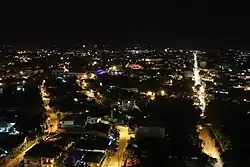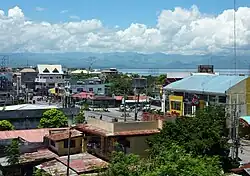Mati | |
|---|---|
| City of Mati | |
Clockwise from top: Capitol Hill, Mati Centennial Park and Clock, Guang-guang Mangrove Nature Reserve, Dahican Beach, Mati Downtown, The Pylon | |
 Flag  Seal | |
| Etymology: Maa-ti (dries up quickly) | |
Nicknames:
| |
Mottoes:
| |
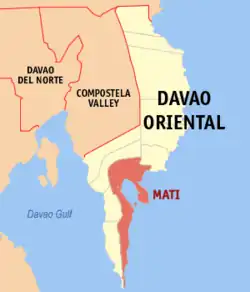 Map of Davao Oriental with Mati highlighted | |
OpenStreetMap | |
.svg.png.webp) Mati Location within the Philippines | |
| Coordinates: 6°56′54″N 126°13′38″E / 6.9483°N 126.2272°E | |
| Country | Philippines |
| Region | Davao Region |
| Province | Davao Oriental |
| District | 2nd district |
| Founded | 1861 |
| Incorporated | October 29, 1903 |
| Cityhood | June 16, 2007 (Lost cityhood in 2008 and 2010) |
| Affirmed Cityhood | February 15, 2011 |
| Barangays | 26 (see Barangays) |
| Government | |
| • Type | Sangguniang Panlungsod |
| • Mayor | Michelle Nakpil Rabat (PDP–Laban) |
| • Vice Mayor | Lorenzo Leon Garcia Rabat (HNP) |
| • Representative | Cheeno Miguel Diez Almario (Lakas–CMD) |
| • City Council | Members |
| • Electorate | 96,387 registered voters (2022) |
| Area | |
| • Total | 588.63 km2 (227.27 sq mi) |
| Elevation | 98 m (322 ft) |
| Highest elevation | 2,320 m (7,610 ft) |
| Lowest elevation | 0 m (0 ft) |
| Population (2020 census)[3] | |
| • Total | 147,547 |
| • Density | 250/km2 (650/sq mi) |
| • Households | 35,137 |
| Demonym | Matinians |
| Economy | |
| • Income class | 5th city income class |
| • Poverty incidence | 21.51 |
| • Revenue | ₱ 1,260 million (2020) |
| • Assets | ₱ 1,638 million (2020) |
| • Expenditure | ₱ 1,162 million (2020) |
| • Liabilities | ₱ 520.1 million (2020) |
| Service provider | |
| • Electricity | Davao Oriental Electric Cooperative (DORECO) |
| Time zone | UTC+8 (PST) |
| ZIP code | 8200 |
| PSGC | |
| IDD : area code | +63 (0)87 |
| Spoken languages and dialects | Cebuano Filipino English Mandaya |
| Website | www |
Mati, officially the City of Mati (Cebuano: Dakbayan sa Mati; Filipino: Lungsod ng Mati / Siyudad ng Mati), is a 5th class component city and capital of the province of Davao Oriental, Philippines located on the southeasternmost side of Mindanao and is part of Metropolitan Davao, the second-most populous metropolitan area in the Philippines, and its managing entity, the MDDA.[5][6] According to the 2020 census, it has a population of 147,547 people.[7]
Mati has three bays, namely Pujada, Mayo, and Balete. These bays were listed as one of the world’s most beautiful bays, a lone distinction of having all three bays in one city, by the association of the Most Beautiful Bays in the World (Les Plus Belles Baies du Monde) in 2022.[8][9]
The east side of Mount Hamiguitan, a UNESCO World Heritage Site, facing sunrise and the three bays of Mati, is located within Mati's territorial jurisdiction.
In the 2023 Cities and Municipalities Competitiveness Index (CMCI), Mati ranked 39th out of 114 overall on the competitive component cities in the Philippines.[10] Since 2020, the city government of Mati has been a consistent recipient of the Department of the Interior and Local Government Seal of Good Local Governance, and Good Financial Housekeeping.[11][12][13]
History
.jpg.webp)
Mati comes from the Mandaya word Maa-ti, which refers to the town's creek that easily dries up even after heavy rain. Pioneer settlers were the Austronesian indigenous peoples Mandaya and Kalagan, and the Arabic-Indo-Malayan-influenced Maguindanao and Maranao.
Spanish period
Captain Prudencio Garcia, the pioneer political-military head in 1861, and his comrade Juan Nazareno founded the settlement of Mati and two other communities in Davao Oriental.[14]
American period
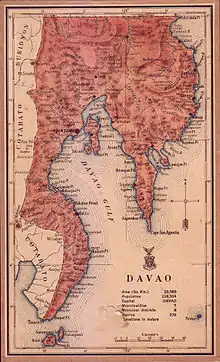
By October 29, 1903, Mati was declared a municipality by virtue of Act No. 21.[14] By 1907, Act No. 189 further reaffirmed the establishment of its local government. Francisco Rojas was the first appointed mayor while the first elected mayor was Patricio Cunanan in 1923. Mati became the capital of Davao Oriental in 1967.
Japanese occupation and World War II
The Japanese Imperial forces landed in town and occupied most of eastern Davao region in 1942. Mati was liberated in 1945 by the Allied Philippine Commonwealth troops of the 6th, 10th, 101st, 102nd, 103rd, 104th, 106th, 107th and 110th Infantry Division of the Philippine Commonwealth Army, 10th Infantry Regiment of the Philippine Constabulary and the Davaoeño guerrilla units.
Contemporary Period
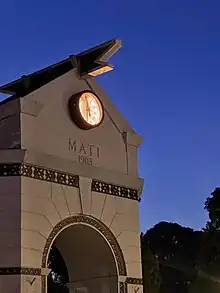
Mati celebrated its grand centennial of its founding as a town in 2003.[15]
Cityhood
On June 20, 2007, the Commission on Elections officially proclaimed the ratification of Republic Act 9408 converting the Municipality of Mati into a component city.
There were 18,267 actual voters out of the 51,287 registered voters in 26 villages and 266 polling precincts during the June 18 plebiscite. Final tabulation showed Yes – 18,267 votes (35.6%); No – 846 (1.6%).[16]
The Supreme Court declared the cityhood law of Mati and 15 other cities unconstitutional after a petition filed by the League of Cities of the Philippines in its ruling on November 18, 2008. On December 22, 2009, the cityhood law of Mati and 15 other municipalities regain its status as cities again after the court reversed its ruling on November 18, 2008. On August 23, 2010, the court reinstated its ruling on November 18, 2008, causing Mati and 15 cities to become regular municipalities. Finally, on February 15, 2011, Mati becomes a city again including the 15 municipalities declaring that the conversion to cityhood met all legal requirements.
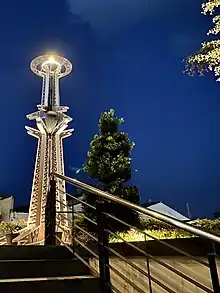
After six years of legal battle, in its board resolution, the League of Cities of the Philippines acknowledged and recognized the cityhood of Mati and 15 other cities.
Geography
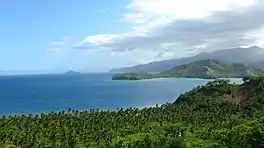
Mati is home to three protected areas, the Mount Hamiguitan Range Wildlife Sanctuary, Mati Protected Landscape, and Pujada Bay Protected Landscape and Seascape. The Dahican Beach is also frequented by tourists and locals.
Barangays
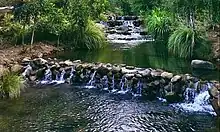
Mati is politically subdivided into 26 barangays. Each barangay consists of puroks while some have sitios.
In 1957, the barrio then known as Cabuaya was renamed to Dawan.[17]
- Badas
- Bobon
- Buso
- Cabuaya
- Central (City Proper)
- Culian
- Dahican
- Danao
- Dawan
- Don Enrique Lopez
- Don Martin Marundan
- Don Salvador Lopez, Sr.
- Langka
- Lawigan
- Libudon
- Luban
- Macambol
- Mamali
- Matiao
- Mayo
- Sainz
- Sanghay
- Tagabakid
- Tagbinonga
- Taguibo
- Tamisan
Climate
City of Mati features a tropical rainforest climate with copious amounts of rainfall throughout the course of the year. There is no pronounced dry season, but it has very pronounced maximum rain from May to July, with June being the wettest month of the year, experiencing 28 days of rain.
The temperature is constant throughout the year. Mati's average yearly rainfall is just over 2,109 mm (83.1 in). February is the driest month of the year, with only 18 rainy days and 141 mm (5.6 in) of precipitation. The average high temperature is 30 °C (85 °F), and the average low temperature is 23 °C (74 °F). The coolest month is July, with 95.2% of all the days of the month having a temperature below 30 °C, and the hottest month is April, with only 62.9% of all the days of the month having a temperature below 30°C.
| Climate data for Mati City | |||||||||||||
|---|---|---|---|---|---|---|---|---|---|---|---|---|---|
| Month | Jan | Feb | Mar | Apr | May | Jun | Jul | Aug | Sep | Oct | Nov | Dec | Year |
| Mean daily maximum °C (°F) | 29 (84) |
29 (84) |
30 (86) |
30 (86) |
30 (86) |
29 (84) |
29 (84) |
29 (84) |
30 (86) |
30 (86) |
29 (84) |
30 (86) |
30 (85) |
| Mean daily minimum °C (°F) | 22 (72) |
22 (72) |
22 (72) |
23 (73) |
24 (75) |
24 (75) |
24 (75) |
24 (75) |
24 (75) |
24 (75) |
24 (75) |
23 (73) |
23 (74) |
| Average precipitation mm (inches) | 168 (6.6) |
141 (5.6) |
143 (5.6) |
141 (5.6) |
216 (8.5) |
235 (9.3) |
183 (7.2) |
169 (6.7) |
143 (5.6) |
176 (6.9) |
226 (8.9) |
168 (6.6) |
2,109 (83.1) |
| Average rainy days | 22.1 | 18.5 | 21.7 | 22.5 | 27.8 | 28.1 | 27.4 | 26.6 | 24.7 | 26.3 | 26.5 | 24.9 | 297.1 |
| Source: Meteoblue[18] | |||||||||||||
Demographics
.jpg.webp)



Mati is the fifth most populous city in Davao Region, after Davao City, Tagum, Panabo, and Digos.[19]
| Year | Pop. | ±% p.a. |
|---|---|---|
| 1903 | 1,365 | — |
| 1918 | 7,649 | +12.18% |
| 1939 | 10,200 | +1.38% |
| 1948 | 11,562 | +1.40% |
| 1960 | 23,479 | +6.08% |
| 1970 | 53,242 | +8.52% |
| 1975 | 73,125 | +6.57% |
| 1980 | 78,178 | +1.34% |
| 1990 | 93,023 | +1.75% |
| 1995 | 93,801 | +0.16% |
| 2000 | 105,908 | +2.64% |
| 2007 | 122,046 | +1.98% |
| 2010 | 126,143 | +1.21% |
| 2015 | 141,141 | +2.16% |
| 2020 | 147,547 | +0.88% |
| Source: Philippine Statistics Authority[20][21][22][23] | ||
Ethnicity and Languages
Cebuano is the most widely spoken language and the corresponding ethnicity (which includes the Boholano subgroup) accounts for 71.55% of the total household population according to a 2000 census. Mandaya ranks second with 12.74%, followed by Kalagan with 6.87%. Most residents of Mati are descendants of migrants from the Visayas who came for employment opportunities in logging, mining, farming, fishing, trading and teaching.[24]
Religion

Roman Catholicism is the major religion in the city, comprising 80% of the total population. Islam comes in second with 8%. Other Christian denominations, like the Iglesia ni Cristo, the Church of Jesus Christ of Latter-day Saints, the United Church of Christ, Seventh Day Adventists, various protestant churches, are in the city as well.[24]
The Cathedral of San Nicolas de Tolentino is the center of Diocese of Mati under the jurisdiction of Roman Catholic Archdiocese of Davao. Two parishes are in Mati: one in the downtown and one in Barangay Dawan.[25]
Economy
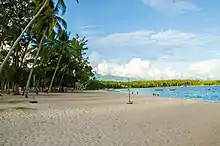

Being the southeasternmost part of Metropolitan Davao, Mati is linked to the markets of Mindanao and Southeast Asia through Davao City. Located around 150 kilometers from the regional economic center, the city serves as the economic hub of the province of Davao Oriental and other nearby municipalities of other provinces. Most of the local people rely on agriculture and agro-industries for a living.
Once heavily dependent on coconut, the city's economy has slowly begun diversifying. The city government has established its own poultry dressing plant,[33] and the Mati Fish Port will be operational, supporting the expansion of the fishing industry in the city. [34] Because of its tropical nature and beaches, the tourism industry in the city has been expanding rapidly in recent years.
Main goods and produce from the city include coconuts, pomelos, bananas, fish, especially tuna and milkfish, poultry, carabao dairy, sunflowers, and edible mushrooms.[35][36] Mining is also a contributor to the city's economy, due to the large deposits of copper on the city's outskirts.[37]
A banking system is found in the city, with a number of different banks providing various financial services to consumers and businesses. Being a vital financial and institutional center in the province, apart from banks, non-bank financial institutions, and offices of government departments and agencies are also found in the city. Despite the lack of significant industries, the city's growing service, tourism, and agricultural sectors have propelled the local economy in recent years.
In the 2022 COA Report[38], the City of Mati ranked fourth out of the six cities in Davao Region with a total revenue of ₱1.803 billion, only after Davao City (₱17.169 billion), Tagum City (₱3.543 billion), and Panabo City (₱1.818 billion), making it a key area for future growth in the region and Metro Davao. Although the youngest city in the region, having regained cityhood status only in 2011, the City of Mati has gradually become an investment hub and is considered one of the emerging cities for doing business with its rapid advancements in government infrastructure and evolving business-friendly environment.
Government
The city's local government is headed by a mayor elected by popular vote. The Vice Mayor serves as the presiding officer of the Sangguniang Panlungsod, with ten Councilors elected by popular vote as its members.
The Sangguniang Panlungsod serves as the city's legislative body and its role is to enact ordinances, approve resolutions, appropriate funds for the general welfare of the city and its inhabitants. Both the council members and the mayor serve three-year terms; and eligible for re-election for two more three-year terms.[39]
| Mayor | Term |
|---|---|
| Francisco G. Rabat | June 30, 2001 – June 30, 2007 |
| Michelle N. Rabat | June 30, 2007 – June 30, 2013 |
| Carlo P. Rabat | June 30, 2013 – June 30, 2019 |
| Michelle N. Rabat | June 30, 2019 – Present |
| Vice mayor | Term |
|---|---|
| Cesar A. de Erio | June 30, 2001 – June 30, 2010 |
| Carlo P. Rabat | June 30, 2010 – June 30, 2013 |
| Glenda S. Rabat-Gayta | June 30, 2013 – June 30, 2022 |
| Lorenzo Leon G. Rabat | June 30, 2022 – Present |
Culture
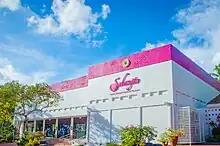
.jpg.webp)
Mati celebrates two annual grand festivals: the Pujada Bay Festival every June and the Sambuokan Festival every October. Compared to the Kadayawan of Davao and other festivals, both of Mati's are relatively new. The Pujada Bay Festival started in 2004 to promote and protect Pujada Bay, while the Sambuokan Festival started in 2001 to unite Matinians during the commemoration of the municipality's founding anniversary every October 29. In years, both festivals have become alternative tourist destinations as competitors from various regions in the country start pouring in for competitions like streetdancing, boat racing, skimboarding, and frisbee. In 2022, the city government, together with the Department of Tourism, launched BAY DEEP MATI, a freediving festival that is the first in the country. [40]
Fiestas and Festivals
- Rajah Sports Fest – every June 10 to 19 and every October 10 to 24
- Pujada Bay Festival – every June 12 to 19
- BAY DEEP MATI Freediving Festival – every June 17 to 19
- Citihood Day - every June 19
- Tour de Mati – every June 19
- Parochial Town Fiesta – every September 10
- Sambuokan Festival - every October 23 to 27
- Abunda Festival - every October 23 to 27
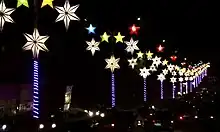
- KrismaSayahan – every December 1 to January 1
Education and Sports
Mati is the educational center of the province of Davao Oriental, with the main campus of Davao Oriental State University located in Dahican, as is the Davao Oriental Regional Science High School. There are two other colleges in the city: Mati Polytechnic College and Mati Doctors College.
In basic education, seven private schools, sixteen public high schools, and a number of public elementary schools are located in the city.[41] The City Schools Division of Mati supervises these schools.
In 2003, Mati hosted the Mindanao Games organized by the Philippine Sports Commission together with the then-municipal government and was attended by about 4,000 athletes and delegation members from more than 41 local government units.[42] Recently, Mati hosted the Mindanao Association of State Tertiary Schools (MASTS) Games in 2014 and 2022.
Insfrastructure
Transportation
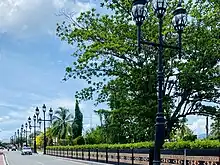
The pedicab or tricycle is the major means of transportation around the city. In recent years, underbone motorcycles have earned quite a popularity among professionals and students, thus easily becoming a public transport alternative to commuters who prefer more speed. Jeepneys are available for travels from Mati to its neighboring towns while vans and buses are still the only means of transportation from Mati to other cities.
Mati Airport serves the city, but only accommodates chartered flights. In 2022, plans to expand the airport to accommodate commercial operations were revived.[43]
There is also a seaport in Mati. The Mati Seaport in Pujada Bay is one of only three seaports in the whole province of Davao Oriental.
Power
Mati is served by the Davao Oriental Electric Cooperative for its power needs.
Water service
The Mati Water District is the local water provider for the city.
Sister cities
See also
References
- ↑ City of Mati | (DILG)
- ↑ "2015 Census of Population, Report No. 3 – Population, Land Area, and Population Density" (PDF). Philippine Statistics Authority. Quezon City, Philippines. August 2016. ISSN 0117-1453. Archived (PDF) from the original on May 25, 2021. Retrieved July 16, 2021.
- ↑ Census of Population (2020). "Region XI (Davao Region)". Total Population by Province, City, Municipality and Barangay. Philippine Statistics Authority. Retrieved July 8, 2021.
- ↑ "PSA Releases the 2018 Municipal and City Level Poverty Estimates". Philippine Statistics Authority. December 15, 2021. Retrieved January 22, 2022.
- ↑ "AN ACT CREATING THE METROPOLITAN DAVAO DEVELOPMENT AUTHORITY" (PDF). Retrieved April 29, 2021.
- ↑ Cervantes, Filane Mikee (November 23, 2022). "Implementation of Metropolitan Davao Dev't Authority law pushed". Philippine News Agency. Archived from the original on November 29, 2022.
- ↑ "Philippine Standard Geographic Code (PSGC) | Philippine Statistics Authority". psa.gov.ph. Retrieved July 13, 2019.
- ↑ "Pujada Bay - Les Plus Belles Baies du Monde".
- ↑ "Pujada, 2 others in Mati listed among world's most beautiful bays".
- ↑ "2023 RANKINGS OF COMPONENT CITIES".
- ↑ "2021 Good Financial Housekeeping Passers" (PDF).
- ↑ "SEAL OF GOOD LOCAL GOVERNANCE - INCENTIVE FUND (SGLG-IF) REGIONAL ROLL-OUT F.Y. 2022".
- ↑ "SEAL OF GOOD LOCAL GOVERNANCE 2023 Awardees" (PDF).
- 1 2 "History of Davao Oriental". Retrieved August 26, 2021.
- ↑ "DECLARING 2003 AS THE CENTENNIAL YEAR OF THE MUNICIPALITY OF MATI, PROVINCE OF DAVAO ORIENTAL". May 9, 2003. Retrieved October 1, 2021.
- ↑ Sun.Star Davao - Mati now a city Archived June 30, 2007, at the Wayback Machine
- ↑ "An Act Changing the Name of the Barrio of Cabuaya, Municipality of Mati, Province of Davao, to Barrio Dawan". LawPH.com. Retrieved April 12, 2011.
- ↑ "Mati City: Average Temperatures and Rainfall". Meteoblue. Retrieved November 18, 2019.
- ↑ "Population of Region XI - Davao (Based on the 2015 Census of Population)". Philippine Statistics Authority. Retrieved March 27, 2017.
- ↑ Census of Population (2015). "Region XI (Davao Region)". Total Population by Province, City, Municipality and Barangay. Philippine Statistics Authority. Retrieved June 20, 2016.
- ↑ Census of Population and Housing (2010). "Region XI (Davao Region)" (PDF). Total Population by Province, City, Municipality and Barangay. National Statistics Office. Retrieved June 29, 2016.
- ↑ Censuses of Population (1903–2007). "Region XI (Davao Region)". Table 1. Population Enumerated in Various Censuses by Province/Highly Urbanized City: 1903 to 2007. National Statistics Office.
{{cite encyclopedia}}: CS1 maint: numeric names: authors list (link) - ↑ "Province of Davao Oriental". Municipality Population Data. Local Water Utilities Administration Research Division. Retrieved December 17, 2016.
- 1 2 "About". Official Website of the City of Mati. Retrieved April 21, 2014.
- ↑ "Parishes and Parochial Clergy - Diocese of Mati". CBCP Online. Retrieved March 16, 2017.
- ↑ "Poverty incidence (PI):". Philippine Statistics Authority. Retrieved December 28, 2020.
- ↑ "Estimation of Local Poverty in the Philippines" (PDF). Philippine Statistics Authority. November 29, 2005.
- ↑ "2003 City and Municipal Level Poverty Estimates" (PDF). Philippine Statistics Authority. March 23, 2009.
- ↑ "City and Municipal Level Poverty Estimates; 2006 and 2009" (PDF). Philippine Statistics Authority. August 3, 2012.
- ↑ "2012 Municipal and City Level Poverty Estimates" (PDF). Philippine Statistics Authority. May 31, 2016.
- ↑ "Municipal and City Level Small Area Poverty Estimates; 2009, 2012 and 2015". Philippine Statistics Authority. July 10, 2019.
- ↑ "PSA Releases the 2018 Municipal and City Level Poverty Estimates". Philippine Statistics Authority. December 15, 2021. Retrieved January 22, 2022.
- ↑ "Mati City to invest in Halal-certified chicken dressing plant". mb.com.ph. Retrieved October 9, 2020.
- ↑ "Construction of P150-M modern fish port in Mati City under way". mb.com.ph. Retrieved June 21, 2021.
- ↑ "Mati City LGU invites public to visit Sunflower Farm". mindanao.politiko.com.ph. Retrieved November 5, 2023.
- ↑ "Initial 16 hybrid carabaos arrive for Mati's dairy plant". themindanaojournal.com. Retrieved April 23, 2021.
- ↑ "Mati Travel Guide, Philippines | Travelgrove.com". travelgrove.com. Retrieved March 30, 2011.
- ↑ "Financial Profile - Cities Calendar Year 2022". coa.gov.ph. Retrieved December 20, 2023.
- ↑ "Powers and Duties: City Mayor, Vice Mayor, Councilor in the Philippines". May 2021.
- ↑ "Mati City holds PH's first freediving festival". PNA. September 25, 2022. Retrieved September 25, 2022.
- ↑ "Mati City Public High School". Philippines Schools. July 17, 2012. Retrieved March 16, 2017.
- ↑ "Mindanao Games kick off at Davao Oriental". Philstar.com. October 19, 2003. Retrieved December 13, 2023.
- ↑ "Davao Oriental eyes maiden flight at Mati Airport in early 2023". Rappler. November 4, 2022. Retrieved December 13, 2023.
- ↑ "DAVAO CITY, MATI CITY INK SISTERHOOD DEAL". davaocity.gov.ph. Retrieved December 13, 2023.

_II.jpg.webp)
.jpg.webp)
_II.jpg.webp)

.jpg.webp)


